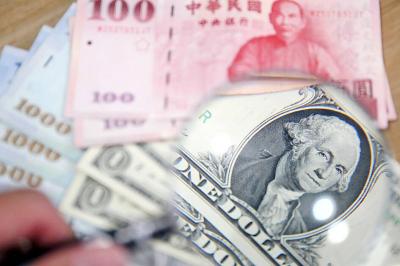The US stock market has been on a tear, yet the country’s economy is in the dumps. So why do so many people believe — undoubtedly incorrectly — that the stock market has decoupled from reality?
The economy many people experience, while bleak, is local, personal and, for the most part, either not publicly traded or plays only a small part in the stock market’s moves. To explain why these personal experiences have so little effect on equity markets, we must look more closely at the market role of the weakest industry sectors.
The surprising conclusion: The most visible and economically vulnerable industries are also among the smallest, based on their market-capitalization weight in major indices such as the S&P 500. Markets, it turns out, are not especially vulnerable to highly visible, but relatively tiny industries.

Photo: Reuters
The 30 most economically damaged industry categories could be delisted before tomorrow’s market open, and it would hardly shave more than a few percentage points off the S&P 500.
This is so despite the worst US economic collapse since the Great Depression. All of the economic data are so bad that figures on GDP, unemployment and initial jobless claims must be re-scaled to even fit on charts.
However, the US economy is not the stock market and vice versa. Ignoring overseas strength is a major oversight. The so-called FAANG — Facebook Inc, Apple Inc, Amazon.com Inc, Netflix Inc and Google parent Alphabet Inc — along with Microsoft Corp, derive about half — and in some cases even more — of their revenue from abroad.
Beyond that, the COVID-19 pandemic lockdown in the US has benefited the giant tech companies’ sales and profits. No wonder the NASDAQ Composite 100 Index, which is dominated by big tech companies, is up about 26 percent this year.
However, a reasonable person might argue that GDP fell by about one-third in the second quarter and the S&P 500 should be in synch with that.
What is more, of the 500 companies in the S&P 500, about 450 of them are doing terribly. Industries such as retail, travel, energy, entertainment and dining have seen sales evaporate.
Bankruptcies are piling up — legendary retailer Lord & Taylor is just the latest — and more are surely coming. Yet, the S&P 500, after a huge plunge in March, is up 2 percent this year.
Market capitalization explains why.
Start with some of this year’s worst-performing industries: As of the end of last month, these include department stores, down 62.6 percent; airlines, off 55 percent; travel services, down 51.4 percent; oil and gas equipment and services, down 50.5 percent; resorts and casinos, down 45.4 percent; and hotel and motel real-estate investment trusts, off 41.9 percent. The next 15 industry sectors in the index are down between 30.5 percent and 41.7 percent. That is four months after the market rebounded from the lows of late March.
These are highly visible industries, with companies that are well-covered by the news media with household names known to many consumers. Retailers are everywhere we go. Gas stations, chain restaurants and hotels are ubiquitous in cities and suburbs across the country.
So although high visibility industries might be of considerable significance to the economy, they are not very significant to the capitalization-weighted stock market indices.
Consider how little these beaten-up sectors mentioned above affect the indices. Department stores might have fallen 62.3 percent, but on a market-cap basis they are a mere 0.01 percent of the S&P 500. Airlines are larger, but not much: They weigh in at 0.18 percent of the index. The story is the same for travel services, hotel and motel real-estate investment trusts, and resorts and casinos.
The market is telling us that these industries just do not matter very much to stock market performance.
And the sectors that do matter? Consider that just four industry groups — Internet content, software infrastructure, consumer electronics and Internet retailers — account for more than US$8 trillion in market value, or almost one-quarter of total US stock market value of about US$35 trillion.
Take the 10 biggest technology companies in the S&P 500 and weight them equally, and they would be up more than 37 percent for the year. Do the same for the next 490 names in the index, and they are down about 7.7 percent. That shows just how much a few giant matter to the index.
On some level, it is completely understandable why many people believe that markets are no longer tethered to reality, because the performance does not correspond to their personal experience, which is one of job loss, economic hardship and personal despair.
However, what is important to understand is that indices based on market-cap weighting can be — as they are now — driven by the gains of just a handful of companies.
We can argue about whether the way the market reacts is good or bad and never reach a satisfying conclusion.
However, one thing the market is not is irrational or disconnected from is the reality of market capitalization, and its impact on stock indices.
Barry Ritholtz is a Bloomberg Opinion columnist. He is chairman and chief investment officer of Ritholtz Wealth Management and was previously chief market strategist at Maxim Group. He is the author of Bailout Nation.
This column does not necessarily reflect the opinion of the editorial board or Bloomberg LP and its owners.

The US dollar was trading at NT$29.7 at 10am today on the Taipei Foreign Exchange, as the New Taiwan dollar gained NT$1.364 from the previous close last week. The NT dollar continued to rise today, after surging 3.07 percent on Friday. After opening at NT$30.91, the NT dollar gained more than NT$1 in just 15 minutes, briefly passing the NT$30 mark. Before the US Department of the Treasury's semi-annual currency report came out, expectations that the NT dollar would keep rising were already building. The NT dollar on Friday closed at NT$31.064, up by NT$0.953 — a 3.07 percent single-day gain. Today,

‘SHORT TERM’: The local currency would likely remain strong in the near term, driven by anticipated US trade pressure, capital inflows and expectations of a US Fed rate cut The US dollar is expected to fall below NT$30 in the near term, as traders anticipate increased pressure from Washington for Taiwan to allow the New Taiwan dollar to appreciate, Cathay United Bank (國泰世華銀行) chief economist Lin Chi-chao (林啟超) said. Following a sharp drop in the greenback against the NT dollar on Friday, Lin told the Central News Agency that the local currency is likely to remain strong in the short term, driven in part by market psychology surrounding anticipated US policy pressure. On Friday, the US dollar fell NT$0.953, or 3.07 percent, closing at NT$31.064 — its lowest level since Jan.

The New Taiwan dollar and Taiwanese stocks surged on signs that trade tensions between the world’s top two economies might start easing and as US tech earnings boosted the outlook of the nation’s semiconductor exports. The NT dollar strengthened as much as 3.8 percent versus the US dollar to 30.815, the biggest intraday gain since January 2011, closing at NT$31.064. The benchmark TAIEX jumped 2.73 percent to outperform the region’s equity gauges. Outlook for global trade improved after China said it is assessing possible trade talks with the US, providing a boost for the nation’s currency and shares. As the NT dollar

The Financial Supervisory Commission (FSC) yesterday met with some of the nation’s largest insurance companies as a skyrocketing New Taiwan dollar piles pressure on their hundreds of billions of dollars in US bond investments. The commission has asked some life insurance firms, among the biggest Asian holders of US debt, to discuss how the rapidly strengthening NT dollar has impacted their operations, people familiar with the matter said. The meeting took place as the NT dollar jumped as much as 5 percent yesterday, its biggest intraday gain in more than three decades. The local currency surged as exporters rushed to